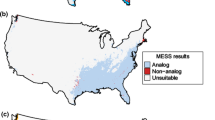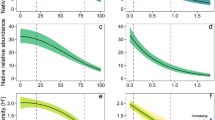Abstract
Understanding species abundances and distributions, especially at local to landscape scales, is critical for land managers and conservationists to prioritize management decisions and informs the effort and expense that may be required. The metrics of range size and local abundance reflect aspects of the biology and ecology of a given species, and together with its per capita (or per unit area) effects on other members of the community comprise a well-accepted theoretical paradigm describing invasive species. Although these metrics are readily calculated from vegetation monitoring data, they have not generally (and effect in particular) been applied to native species. We describe how metrics defining invasions may be more broadly applied to both native and invasive species in vegetation management, supporting their relevance to local scales of species conservation and management. We then use a sample monitoring dataset to compare range size, local abundance and effect as well as summary calculations of landscape penetration (range size × local abundance) and impact (landscape penetration × effect) for native and invasive species in the mixed-grass plant community of western North Dakota, USA. This paper uses these summary statistics to quantify the impact for 13 of 56 commonly encountered species, with statistical support for effects of 6 of the 13 species. Our results agree with knowledge of invasion severity and natural history of native species in the region. We contend that when managers are using invasion metrics in monitoring, extending them to common native species is biologically and ecologically informative, with little additional investment.



Similar content being viewed by others
Data Availability
We intend to archive our data on the Ag Data Commons repository operated by the United States Department of Agriculture National Agricultural Library (https://data.nal.usda.gov).
References
Andrewartha HG, Birch LC (1954) The distribution and abundance of animals. University of Chicago Press, Chicago
Austin M (2007) Species distribution models and ecological theory: a critical assessment and some possible new approaches. Ecol Modell 200:1–19
Barker WT, Whitman WC (1988) Vegetation of the northern Great Plains. Rangelands 10:266–272
Bates D, Mächler M, Bolker BM, Walker SC (2015) Fitting linear mixed-effects models using lme4. J Stat Softw 67:1–48. https://doi.org/10.18637/jss.v067.i01
Briggs JM, Knapp AK, Brock BL (2002) Expansion of woody plants in tallgrass prairie: a fifteen-year study of fire and fire-grazing interactions. Am Midl Nat 147:287–294. https://doi.org/10.1674/0003-0031(2002)147%5b0287:EOWPIT%5d2.0.CO;2
Brown JH (1984) On the Relationship between abundance and distribution of species. Am Nat 124:255–279. https://doi.org/10.1086/284267
Bruno JF, Kennedy CW, Rand TA, Grant MB (2004) Landscape-scale patterns of biological invasions in shoreline plant communities. Oikos 107:531–540. https://doi.org/10.1111/j.0030-1299.2004.13099.x
Bullock JM (2006) Plants. In: Sutherland WJ (ed) Ecological census techniques: a handbook. Cambridge University Press, Cambridge, pp 186–212
Daubenmire R (1966) Vegetation: identification of typal communities. Science 151:291–298. https://doi.org/10.1126/science.151.3708.291
DeKeyser ES, Dennhardt LA, Hendrickson J (2015) Kentucky bluegrass (Poa pratensis) invasion in the northern Great Plains: a story of rapid dominance in an endangered ecosystem. Invasive Plant Sci Manag 8:255–261. https://doi.org/10.1614/IPSM-D-14-00069.1
Egler FE (1954) Vegetation science concepts I. Initial floristic composition, a factor in old-field vegetation development with 2 figs. Veg Acta Geobot 4:412–417. https://doi.org/10.1007/BF00275587
Eldridge DJ, Bowker MA, Maestre FT et al (2011) Impacts of shrub encroachment on ecosystem structure and functioning: towards a global synthesis. Ecol Lett 14:709–722. https://doi.org/10.1111/j.1461-0248.2011.01630.x
Eriksson O, Jakobsson A (1998) Abundance, distribution and life histories of grassland plants: a comparative study of 81 species. J Ecol 86:922–933. https://doi.org/10.1046/j.1365-2745.1998.00309.x
Espeland EK, Emam TM (2011) The value of structuring rarity: the seven types and links to reproductive ecology. Biodivers Conserv 20:963–985. https://doi.org/10.1007/s10531-011-0007-2
Ewers RM, Didham RK (2006) Confounding factors in the detection of species responses to habitat fragmentation. Biol Rev 81:117–142. https://doi.org/10.1017/S1464793105006949
Gomola CE, Espeland EK, McKay JK (2017) Genetic lineages of the invasive Aegilops triuncialis differ in competitive response to neighboring grassland species. Biol Invasions 19:469–478. https://doi.org/10.1007/s10530-016-1366-0
Grime JP (1977) Evidence for the existence of three primary strategies in plants and its relevance to ecological and evolutionary theory. Am Nat 111:1169–1194. https://doi.org/10.1086/283244
IUCN (2012) IUCN red list categories and criteria version 3.1. 2nd edn. Gland, Switzerland and Cambridge, UK
Johnson JR, Larson GE (2007) Grassland plants of South Dakota and the northern Great Plains. South Dakota State University College of Agriculture and Biological Sciences, Brookings
Krebs CJ (1985) Ecology: the experimental analysis of distribution and abundance, 3rd edn. Harper and Row, New York
Kuznetsova A, Brockhoff P, Christensen R (2016) lmerTest: tests in linear mixed effects models. R Packag version 3.0.0:https://cran.r-project.org/package=lmerTest
Larson G, Johnson J (2007) Plants of the Black Hills and Bear Lodge Mountains. South Dakota State University College of Agriculture and Biological Sciences, Brookings
Mehta SV, Haight RG, Homans FR et al (2007) Optimal detection and control strategies for invasive species management. Ecol Econ 61:237–245. https://doi.org/10.1016/j.ecolecon.2006.10.024
Morlon H, White EP, Etienne RS et al (2009) Taking species abundance distributions beyond individuals. Ecol Lett 12:488–501. https://doi.org/10.1111/j.1461-0248.2009.01318.x
NRCS (2005) Nassella viridula plant fact sheet. USDA NRCS Plant Materials Center, Bismarck
Parker I, Simberloff D, Lonsdale W (1999) Impact: toward a framework for understanding the ecological effects of invaders. Biol Invasions 1:3–19. https://doi.org/10.1023/A:1010034312781
Pearson RG, Dawson TP (2003) Predicting the impacts of climate change on the distribution of species: are bioclimate envelope models useful? Glob Ecol Biogeogr 12:361–371. https://doi.org/10.1046/j.1466-822X.2003.00042.x
Pearson DE, Ortega YK, Eren O, Hierro JL (2016) Quantifying apparent impact and distinguishing impact from invasiveness in multispecies plant invasions. Ecol Appl 26:162–173. https://doi.org/10.1890/14-2345.1/suppinfo
Preston TM (2015) Presence and abundance of non-native plant species associated with recent energy development in the Williston Basin. Environ Monit Assess 187:200
Pringle RM, Tarnita CE (2017) Spatial self-organization of ecosystems: integrating multiple mechanisms of regular-pattern formation. Annu Rev Entomol 62:359–377. https://doi.org/10.1146/annurev-ento-031616-035413
R Core Team (2016) R: a language and environment for statistical computing. R Foundation for Statistical Computing, Vienna
Rabinowitz D (1981) Seven forms of rarity. In: Synge H (ed) The biological aspects of rare plant conservation. Wiley, New York, pp 205–217
Rinella MJ, Espeland EK, Moffatt BJ (2016) Studying long-term, large-scale grassland restoration outcomes to improve seeding methods and reveal knowledge gaps. J Appl Ecol 53:1565–1574. https://doi.org/10.1111/1365-2664.12722
Saint-Germain M, Buddle CM, Larrivée M et al (2007) Should biomass be considered more frequently as a currency in terrestrial arthropod community analyses? J Appl Ecol 44:330–339. https://doi.org/10.1111/j.1365-2664.2006.01269.x
Saunders DA, Hobbs RJ, Margules CR (1991) Biological consequences of ecosystem fragmentation: a review. Conserv Biol 5:18–32
Schwinning S, Weiner J (1998) Mechanisms determining the degree of size asymmetry in competition among plants. Oecologia 113:447–455
Soil Survey Staff. USDA-NRCS web soil survey. https://websoilsurvey.sc.egov.usda.gov
Stubbendieck J, Hatch S, Butterfield C (1997) North American range plants, 5th edn. University of Nebraska Press, Lincoln
Thiele J, Kollmann J, Markussen B, Otte A (2010) Impact assessment revisited: improving the theoretical basis for management of invasive alien species. Biol Invasions 12:2025–2035. https://doi.org/10.1007/s10530-009-9605-2
Thuiller W, Albert C, Araujo MB et al (2008) Predicting global change impacts on plant species’ distributions: future challenges. Perspect Plant Ecol Evol Syst 9:137–152. https://doi.org/10.1016/j.ppees.2007.09.004
Toledo D, Sanderson M, Spaeth K et al (2014) Extent of Kentucky bluegrass and its effect on native plant species diversity and ecosystem services in the northern Great Plains of the United States. Invasive Plant Sci Manag 7:543–552. https://doi.org/10.1614/IPSM-D-14-00029.1
Trinder CJ, Brooker RW, Robinson D (2013) Plant ecology’s guilty little secret: understanding the dynamics of plant competition. Funct Ecol 27:918–929. https://doi.org/10.1111/1365-2435.12078
Tylianakis JM, Didham RK, Bascompte J, Wardle DA (2008) Global change and species interactions in terrestrial ecosystems. Ecol Lett 11:1351–1363
Ulrich E, Perkins L (2014) Bromus inermis and Elymus canadensis but not Poa pratensis demonstrate strong competitive effects and all benefit from priority. Plant Ecol 215:1269–1275. https://doi.org/10.1007/s11258-014-0385-0
Van Auken OW (2000) Shrub invasions of North American semiarid grasslands. Annu Rev Ecol Syst 31:197–215. https://doi.org/10.1146/annurev.ecolsys.31.1.197
Volkov I, Banavar JR, Hubbell SP, Maritan A (2003) Neutral theory and relative species abundance in ecology. Nature 424:1035–1037. https://doi.org/10.1038/nature01883
Williams J, Morris L, Gunnell K et al (2017) Variation in sagebrush communities historically seeded with crested wheatgrass in the eastern Great Basin. Range Ecol Manag 70:683–690
Acknowledgements
We thank D. Branson, L. Igl, L. Knotts, L. McNew, and T. Rand for their assistance in establishing the sampling design. M. O’Mara provided GIS expertise for site selection and led T. Besosa and A. Guggenheimer in data collection. J. Diaz, T. Rand, D. Strong, and J. Hendrickson commented on the manuscript. Y. Ortega provided assistance in model construction. Funding supplied by USDA appropriated project #5436-22000-017-00.
Author information
Authors and Affiliations
Corresponding author
Additional information
Communicated by David Hawksworth.
This article belongs to the Topical Collection: Biodiversity protection and reserves.
Electronic supplementary material
Below is the link to the electronic supplementary material.
Rights and permissions
About this article
Cite this article
Espeland, E.K., Sylvain, Z.A. Range size, local abundance and effect inform species descriptions at scales relevant for local conservation practice. Biodivers Conserv 28, 909–920 (2019). https://doi.org/10.1007/s10531-019-01701-2
Received:
Revised:
Accepted:
Published:
Issue Date:
DOI: https://doi.org/10.1007/s10531-019-01701-2




